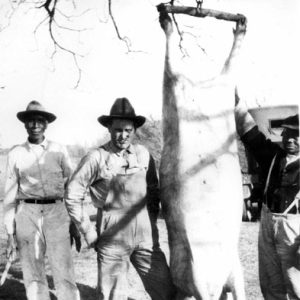calsfoundation@cals.org
Swine Industry
aka: Pig Industry
aka: Pork Industry
Swine (a.k.a. pigs, Sus scrofa) were first introduced into what is now Arkansas by the Spanish explorer Hernando de Soto in 1541. Since pork can be salted and smoked for preservation, many early settlers used pigs to supply their needs for meat and cooking fat (lard). The widespread production of pigs persisted until commercial refrigeration was introduced in the 1930s and 1940s. At that time, pork became available from more remote sources, and production was more specialized and concentrated on fewer farms. In the mid-1970s, integration of pig production began to occur, with four corporations controlling most of the $84,148,000 of pig sales in 2007.
The de Soto expedition had more than 700 pigs when the group was disbanded in 1542. De Soto gave pigs to the Native American chiefs as gifts. It is believed by some that pigs from this expedition were the ancestors of the feral hog called the “razorback,” which is found in the Ouachita Mountains between Mena (Polk County) and Hot Springs (Garland County). The wild pigs in that region have characteristics not evident in the domesticated animals brought from England by early American settlers (circa 1820 and later), such as smaller size, a razor back, wattles on their jowls, and horizontal striping on the bodies of the young. Anthropologist Charles Hudson, however, states that there is no uncontestable evidence that the razorback has de Soto’s hogs in its ancestry. DNA analysis of the few remaining razorback-type hogs would provide evidence as to their origin.
Pigs brought by early settlers were used as scavengers; they ate acorns, shattered grains lost during harvest and threshing, as well as other materials available on the small farms, including table scraps. The resulting pork produced could be preserved by salting and smoking. The pork was consumed in the home or bartered with neighbors. Beef and poultry are not so readily preserved. In addition to the pork, the carcasses provided fat for making lard, which was then used for cooking. Pork was a major source of protein in the diet of early settlers and their slaves. This meat continues to be a major staple in the diet of Arkansans.
Pigs were also raised in the upland areas along the major rivers. When the pigs attained slaughter weight, often at a year of age, they would be driven to the rivers and processed for shipment to population centers where the cured, smoked pork was sold. Arkansas Highway 23 north of Ozark (Franklin County) was called the “pig trail” since many pigs were being driven to Ozark. Use of this name continues today.
After railroads were constructed across Arkansas, farmers with an excess of pigs would ship them by rail to a large market in East St. Louis, Illinois. Arkansas pigs sold at a discount at that market because they were assumed to have been fed on acorns. This resulted in a lard that was not white, and the meat had a flavor different from that of pigs fed corn.
During the 1930s and 1940s, purebred pigs (Berkshires, Chester White, Duroc, Hampshire, Poland China, etc.) were brought into the state by enterprising pig producers who were interested in supplying farmers with pigs having superior qualities (larger litters and faster growth). Around 1950, several swine producers introduced the Yorkshire breed to Arkansas. This was a further attempt to increase litter size and carcass quality as contrasted to breeds available in earlier years. Many of these breed groups had statewide organizations, and several individuals had their own sales of purebred pigs, or the state organization would have an auction whereby several producers would sell pigs at the same sale. During the 1940s, producers began to purchase commercial protein and mineral supplements to mix with locally produced grains. Later, complete feeds were available to producers, and bulk feed (non-sacked) use was initiated in the early 1960s. Use of bulk feed is now universal among the larger producers. In the 1980s, some European wild boars were introduced and raised for hunting purposes. A few Vietnamese pigs were brought into the state as pets.
Herds of feral pigs persist in the entire Buffalo River valley, as well as in many other areas of the state. Most of these pigs exhibit characteristics of modern-day breeds, except for isolated pockets of pigs in west-central Arkansas showing the wattles and coloration of the razorback of earlier years. There is an open hunting season for feral pigs in an attempt to control their numbers. From the 1840s until 1999, a state law prohibited the shooting of roaming pigs since it was assumed that all pigs had an owner. Farmers would notch the ears of their pigs for identification purposes.
In the 1960s, several breeders of purebreds made contributions to the Agricultural Experiment Station of the University of Arkansas (UA) in Fayetteville (Washington County) for the construction of a Performance Test Station at Newport (Jackson County), at which purebred boars could be evaluated for their genetic potential. Such performance traits as growth rate, efficiency of feed utilization, and estimated carcass leanness were evaluated. Tested boars from this station were sold to commercial producers for use in their crossbreeding programs. At this time, most commercial producers were crossing two or more breeds to utilize the benefits of hybrid vigor and some of the useful attributes of the varying respective genetic backgrounds.
During the 1960s, a system of feeder pig (forty to sixty pounds) production evolved, especially in northern Arkansas. Very little corn was grown in this area, so most pig feed had to be brought from Missouri, Iowa, Illinois, and some corn-producing areas in eastern Arkansas. Later, some feeder pigs were sold on a contract basis. The feeder pigs were usually sold to pig growers in the north United States where corn and other feed grains were produced. In later years, the age and weight at weaning were reduced, resulting in pigs being sold at fifteen to twenty pounds.
Some producers in the northeastern part of the state fed locally produced grain to the weaned pigs. The preferred market weight of these pigs was 220 or more pounds, with the finished product selling to terminal markets in East St. Louis, Illinois; Memphis, Tennessee; Little Rock (Pulaski County); and Fort Smith (Sebastian County). Other producers sold their pigs directly to pork-packing plants in Union City, Tennessee; Little Rock; Jonesboro (Craighead County); Morrilton (Conway County); Pine Bluff (Jefferson County); Fort Smith; and a number of smaller local meat shops throughout the state, or to consumers with home freezers.
During the 1970s, two large commercial companies (Cargill and later Tyson Foods) began to contract the production of both feeder pigs and market hogs (220 pounds or more). Contract production has resulted in large numbers of pigs being concentrated on these farms. The producer constructs the necessary buildings, while the contractor supplies the breeding animals, feed, and management supervision. In Arkansas, there are two types of contract production: 1) feeder pigs and 2) growing the feeder pigs to become market hogs—at a slaughter weight of 250-plus pounds. Currently, feeder pigs are the principal product from these Arkansas farms. The pigs are then transported to states where feed grain is produced and plants are available for processing the pork. The concentration of large numbers of pigs on these farms has increased the problems of controlling odors and disposing of the manure produced in a non-polluting manner. As of 2009, several U.S. and multinational companies who sell primary breeding stock to both contract and independent producers throughout the country have swine production units near De Queen (Sevier County). This area was chosen due to its remoteness from large production areas (e.g. Iowa, North Carolina) in an attempt to minimize the possibility of infecting the herds with various diseases.
With the margin of profit from the production of swine having been greatly reduced in the United States, most of the independent swine producers in Arkansas discontinued their swine operations. Almost all of those remaining in production have a contract with one of the integrated swine-producing corporations.
Total Pigs in Arkansas:
1866–2007 December Inventory
|
1866 |
850,000 |
|
1870 |
1,075,000 |
|
1880 |
1,410,000 |
|
1890 |
1,410,000 |
|
1900 |
1,436,000 |
|
1910 |
1,540,000 |
|
1920 |
1,233,000 |
|
1930 |
644,000 |
|
1940 |
1,209,000 |
|
1950 |
811,000 |
|
1960 |
416,000 |
|
1970 |
392,000 |
|
1980 |
720,000 |
|
1990 |
760,000 |
|
2000 |
685,000 |
|
2007 |
290,000 |
Pigs on farms December 1 each year, not including animals sold during the year
Pigs Produced in Leading Counties (2002)
| Howard | 416,704 |
| Sevier | 226,711 |
| Pope | 216,220 |
| Pike | 202,163 |
| Washington | 164,220 |
| Conway | 134,977 |
| Polk | 126,509 |
| Montgomery | 110,521 |
| Yell | 108,120 |
| Hempstead | 93,255 |
| Logan | 42,914 |
| Johnson | 42,439 |
| Van Buren | 38,459 |
| Little River | 32,412 |
| Clark | 28,477 |
| Newton | 28,464 |
| Madison | 24,905 |
| Perry | 24,082 |
Total sales in state—2,408,257. Most of these sales were feeder pigs weighing less than twenty pounds and produced on contract.
For additional information:
Irvin, David. “State’s Hog Farmers Struggling Since 2002.” Arkansas Democrat-Gazette. October 21, 2007, pp. 1G, 10G.
Lancaster, Bob. “The Adelantado’s Pigs.” Arkansas Times, January 1986, 65–76.
“Swine Production in Arkansas.” Pine Bluff: Cooperative Extension Program, University of Arkansas at Pine Bluff, n.d.
Paul Noland
Fayetteville, Arkansas
 Agriculture
Agriculture Mammals
Mammals Petit Jean Meats
Petit Jean Meats Hog Butchering
Hog Butchering 




Comments
No comments on this entry yet.